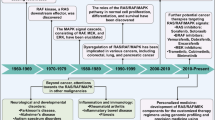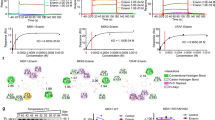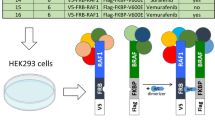Abstract
Activating mutations in KRAS and BRAF are found in more than 30% of all human tumours and 40% of melanoma, respectively, thus targeting this pathway could have broad therapeutic effects1. Small molecule ATP-competitive RAF kinase inhibitors have potent antitumour effects on mutant BRAF(V600E) tumours but, in contrast to mitogen-activated protein kinase kinase (MEK) inhibitors, are not potent against RAS mutant tumour models, despite RAF functioning as a key effector downstream of RAS and upstream of MEK2,3. Here we show that ATP-competitive RAF inhibitors have two opposing mechanisms of action depending on the cellular context. In BRAF(V600E) tumours, RAF inhibitors effectively block the mitogen-activated protein kinase (MAPK) signalling pathway and decrease tumour growth. Notably, in KRAS mutant and RAS/RAF wild-type tumours, RAF inhibitors activate the RAF–MEK–ERK pathway in a RAS-dependent manner, thus enhancing tumour growth in some xenograft models. Inhibitor binding activates wild-type RAF isoforms by inducing dimerization, membrane localization and interaction with RAS–GTP. These events occur independently of kinase inhibition and are, instead, linked to direct conformational effects of inhibitors on the RAF kinase domain. On the basis of these findings, we demonstrate that ATP-competitive kinase inhibitors can have opposing functions as inhibitors or activators of signalling pathways, depending on the cellular context. Furthermore, this work provides new insights into the therapeutic use of ATP-competitive RAF inhibitors.
This is a preview of subscription content, access via your institution
Access options
Subscribe to this journal
Receive 51 print issues and online access
$199.00 per year
only $3.90 per issue
Buy this article
- Purchase on SpringerLink
- Instant access to full article PDF
Prices may be subject to local taxes which are calculated during checkout




Similar content being viewed by others
References
Schubbert, S., Shannon, K. & Bollag, G. Hyperactive Ras in developmental disorders and cancer. Nature Rev. Cancer 7, 295–308 (2007)
Yeh, J. J. et al. KRAS/BRAF mutation status and ERK1/2 activation as biomarkers for MEK1/2 inhibitor therapy in colorectal cancer. Mol. Cancer Ther. 8, 834–843 (2009)
Hoeflich, K. P. et al. Antitumor efficacy of the novel RAF inhibitor GDC-0879 is predicted by BRAFV600E mutational status and sustained extracellular signal-regulated kinase/mitogen-activated protein kinase pathway suppression. Cancer Res. 69, 3042–3051 (2009)
Hansen, J. D. et al. Potent and selective pyrazole-based inhibitors of B-Raf kinase. Bioorg. Med. Chem. Lett. 18, 4692–4695 (2008)
Tsai, J. et al. Discovery of a selective inhibitor of oncogenic B-Raf kinase with potent antimelanoma activity. Proc. Natl Acad. Sci. USA 105, 3041–3046 (2008)
Malek, S. Selective inhibition of Raf results in downregulation of the RAS/RAF/MEK/ERK pathway and inhibition of tumor growth in vivo. Eur. J. Cancer Suppl. 4184 (2006)
Flaherty, K. et al. Phase I study of PLX4032: proof of concept for V600E BRAF mutation as a therapeutic target in human cancer. J. Clin. Oncol. 27 abstract 9000 (2009)
Schwartz, G. K. et al. A phase I study of XL281, a selective oral RAF kinase inhibitor, in patients (Pts) with advanced solid tumors. J. Clin. Oncol. 27 abstract 3513 (2009)
Chapman, P. et al. Early efficacy signal demonstrated in advanced melanoma in a phase I trial of the oncogenic BRAF-selective inhibitor PLX4032. Eur. J. Cancer Suppl. 7,5 (2009)
Jaiswal, B. S. et al. Combined targeting of BRAF and CRAF or BRAF and PI3K effector pathways is required for efficacy in NRAS mutant tumors. PLoS One 4, e5717 (2009)
Garnett, M. J. et al. Wild-type and mutant B-RAF activate C-RAF through distinct mechanisms involving heterodimerization. Mol. Cell 20, 963–969 (2005)
Rushworth, L. K., Hindley, A. D., O'Neill, E. & Kolch, W. Regulation and role of Raf-1/B-Raf heterodimerization. Mol. Cell. Biol. 26, 2262–2272 (2006)
Weber, C. K., Slupsky, J. R., Kalmes, H. A. & Rapp, U. R. Active Ras induces heterodimerization of cRaf and BRaf. Cancer Res. 61, 3595–3598 (2001)
Wan, P. T. et al. Mechanism of activation of the RAF-ERK signaling pathway by oncogenic mutations of B-RAF. Cell 116, 855–867 (2004)
Kim, J. S., Lee, C., Foxworth, A. & Waldman, T. B-Raf is dispensable for K-Ras-mediated oncogenesis in human cancer cells. Cancer Res. 64, 1932–1937 (2004)
Yun, J. et al. Glucose deprivation contributes to the development of KRAS pathway mutations in tumor cells. Science 325, 1555–1559 (2009)
Zang, M. et al. Characterization of Ser338 phosphorylation for Raf-1 activation. J. Biol. Chem. 283, 31429–31437 (2008)
Khazak, V., Astsaturov, I., Serebriiskii, I. G. & Golemis, E. A. Selective Raf inhibition in cancer therapy. Expert Opin. Ther. Targets 11, 1587–1609 (2007)
Goetz, C. A., O’Neil, J. J. & Farrar, M. A. Membrane localization, oligomerization, and phosphorylation are required for optimal raf activation. J. Biol. Chem. 278, 51184–51189 (2003)
Xiang, X. et al. Phosphorylation of 338SSYY341 regulates specific interaction between Raf-1 and MEK1. J. Biol. Chem. 277, 44996–45003 (2002)
Terai, K. & Matsuda, M. Ras binding opens c-Raf to expose the docking site for mitogen-activated protein kinase kinase. EMBO Rep. 6, 251–255 (2005)
Jelinek, T. et al. RAS and RAF-1 form a signalling complex with MEK-1 but not MEK-2. Mol. Cell. Biol. 14, 8212–8218 (1994)
Cameron, A. J. et al. PKC maturation is promoted by nucleotide pocket occupation independently of intrinsic kinase activity. Nature Struct. Mol. Biol. 16, 624–630 (2009)
Okuzumi, T. et al. Inhibitor hijacking of Akt activation. Nature Chem. Biol. 5, 484–493 (2009)
Hindie, V. et al. Structure and allosteric effects of low-molecular-weight activators on the protein kinase PDK1. Nature Chem. Biol. 5, 758–764 (2009)
Rajakulendran, T. et al. A dimerization-dependent mechanism drives RAF catalytic activation. Nature 461, 542–545 (2009)
Wellbrock, C., Karasarides, M. & Marais, R. The RAF proteins take centre stage. Nature Rev. Mol. Cell Biol. 5, 875–885 (2004)
Wallace, E. M. et al. Potent and selective mitogen-activated protein kinase kinase (MEK) 1,2 inhibitors. 1. 4-(4-bromo-2-fluorophenylamino)-1- methylpyridin-2(1H)-ones. J. Med. Chem. 49, 441–444 (2006)
Cheng, Y. & Prusoff, W. H. Relationship between the inhibition constant (K I) and the concentration of inhibitor which causes 50 per cent inhibition (I50) of an enzymatic reaction. Biochem. Pharmacol. 22, 3099–3108 (1973)
Lukyanov, K. A. et al. Natural animal coloration can be determined by a nonfluorescent green fluorescent protein homolog. J. Biol. Chem. 275, 25879–25882 (2000)
Matz, M. V. et al. Fluorescent proteins from nonbioluminescent Anthozoa species. Nature Biotechnol. 17, 969–973 (1999)
Stokoe, D. & McCormick, F. Activation of c-Raf-1 by Ras and Src through different mechanisms: activation in vivo and in vitro. EMBO J. 16, 2384–2396 (1997)
Collaborative Computational Project, Number 4. The CCP4 suite: programs for protein crystallography. Acta Crystallogr. D 50, 760–763 (1994)
Acknowledgements
We would like to thank the chemists at Genentech and Array BioPharma for providing GDC-0879. We thank Oncotest GmbH, L. Murray, S. Gould, B. Alicke, W. Voegtli, K. Bock, H. Stern and the immunohistochemistry core laboratory for technical support. We thank B. Vogelstein for HCT116 isogenic BRAF+/+ and BRAF-/- cell lines, and T. Waldman for the HEC1A BRAF+/+ and BRAF-/- cell lines. Special thanks goes to A. Bruce for help with artwork.
Author Contributions G.H. and S.M. designed the studies, interpreted the data and wrote the manuscript. K.S., I.Y., B.L., S.S. and D.S. conducted cellular experiments and dimerization assays. D.J.A., M.J.C.L. and R.A. conducted microscopy experiments. B.J.B., G.V., T.M. and I.A. conducted crystallography and provided structural input. S.L.G. conducted enzymology. K.P.H. and H.K. conducted in vivo experiments and immunohistochemistry. B.S.J. and S.S. generated inducible shRNA cell lines. M.B. and L.S.F. interpreted the data and wrote the manuscript.
Author information
Authors and Affiliations
Corresponding authors
Ethics declarations
Competing interests
G.H., K.S., I.Y., D.J.A., R.A., M.J.C.L., D.S., I.A., B.L., S.S., K.P.H., B.S.J., S.S., H.K., M.B., L.S.F. and S.M. are employees of Genentech, Inc. B.J.B., S.L.G., T.M. and G.V. are employees of Array BioPharma.
Supplementary information
Supplementary Information
This file contains Supplementary Figures 1-15 with Legends, Supplementary Tables 1-2 and Supplementary References. (PDF 7044 kb)
Rights and permissions
About this article
Cite this article
Hatzivassiliou, G., Song, K., Yen, I. et al. RAF inhibitors prime wild-type RAF to activate the MAPK pathway and enhance growth. Nature 464, 431–435 (2010). https://doi.org/10.1038/nature08833
Received:
Accepted:
Published:
Issue date:
DOI: https://doi.org/10.1038/nature08833
This article is cited by
-
BRAF — a tumour-agnostic drug target with lineage-specific dependencies
Nature Reviews Clinical Oncology (2024)
-
Live-cell target engagement of allosteric MEKi on MEK–RAF/KSR–14-3-3 complexes
Nature Chemical Biology (2024)
-
Disruption of the pro-oncogenic c-RAF–PDE8A complex represents a differentiated approach to treating KRAS–c-RAF dependent PDAC
Scientific Reports (2024)
-
Antiviral mechanisms of sorafenib against foot-and-mouth disease virus via c-RAF and AKT/PI3K pathways
Veterinary Research Communications (2024)
-
Targeting CRAF kinase in anti-cancer therapy: progress and opportunities
Molecular Cancer (2023)



